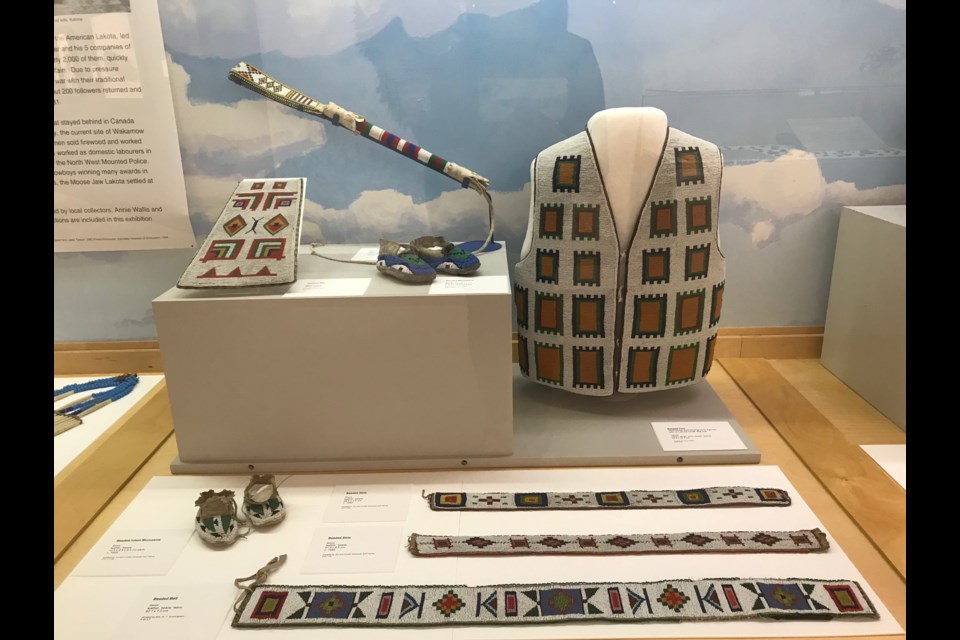Dr. Claire Thomson is the guest curator of the Wakšúpi: Lakota Beadwork exhibition at the Moose Jaw Museum & Art Gallery (MJMAG), opening Sep. 22, which takes a new look at items from the MJMAG Permanent Collection through a uniquely Lakota perspective.
Thomson is a field historian with Parks Canada, the volunteer secretary for the Wood Mountain Historical Society, and recently earned her doctoral degree with the successful defence of her Ph.D thesis on Lakota history in the part of North American now known as southwest Saskatchewan.
Thomson received bachelor's and master's degrees from the University of Saskatchewan before heading to the University of Alberta for her Ph.D.
She defended her dissertation, “Digging Roots and Remembering Relatives: Lakota Kinship and Movement in the Northern Great Plains from the Wood Mountain Uplands Across Lakota Thamakhoche/Lakota Country, 1881-1940,” in 2022, and received the Governor General's Gold Medal in recognition of her outstanding academic achievement.
"A lot of Lakota history is really American focussed, so I wanted to challenge that and bring back local perspectives, and stories from this area, as well," Thomson said in an interview with MooseJawToday.com. "And then, obviously, connect those perspectives and stories with the larger Lakota Nation and with their relatives south of the boundary.
"I really pushed against the dividing of Lakota history into Canadian or American historical containers. Instead, I used the landscape itself, and Lakota understandings and language terms for places. Those relationships aren't captured very well by putting them in a colonial perspective, and in fact, that perspective has done a lot of harm."
Thomson is from the Wood Mountain area. Her family has lived, farmed, and ranched on their own land since the 1880s. Because of her research interests, local roots, and proximity to Moose Jaw, she has had access to the MJMAG archives and collections for several years now.
"I'm definitely not the first person from the Wood Mountain area or the first Lakota person to poke around in those archives, but I was very thankful for all the time I got to spend in there," Thomson said. "And then Jennifer [McRorie, executive director and curator at the MJMAG], asked me if I was interested in curating an exhibit about some of these pieces.
"A lot of museum collections are not well documented as to who made them, and also tend to be quite divorced from their cultural and historical context. ... This will be a new take on connecting all these pieces and seeing them in the context they were created. There is no Lakota word for art, and I'm not saying that Lakota people didn't have their own values of aesthetic and craftsmanship, but these were very much part of their personal, everyday lives."
Thomson was able to get help, including genealogical information, historical photographs, and even personal stories about specific items, from locals whose ancestry in this area goes all the way back. Her boyfriend, for example, is a Lakota speaker and teacher who has helped her with translation work.
Because of all those connections, curating the exhibition has been a highly collaborative process, with input from several communities, MJMAG staff, and fellow Lakota artists and historians.
"It's not just my knowledge going into this. There's lots of different people involved and I'm having a lot of fun with it. I do some similar work to this for my full-time job, but I haven't had the chance before to work with a collection I feel so passionately about."
One of her favourite pieces from the upcoming exhibition is a blue trade-cloth dress decorated with ivory elk teeth. Such a dress would have been a status symbol in Lakota society, recognizing prestigious female community leaders.
"We often talk about men gaining honour, typically through hunting, horse culture, and warfare," Thomson explained. "But women had their own societies and means of earning honour and recognition and status in their families and communities. ... It's a very beautiful piece, and the quality of the trade-cloth is quite stunning."
The opening reception for Wakšúpi: Lakota Beadwork, including a walking tour of the exhibit led by Thomson, takes place Thursday, Sep. 28 at 7 p.m. The reception has been co-ordinated as part of the second annual Every Child Matters powwow by the Wakamow Aboriginal Community Association (WACA).
In response to some providers blocking access to Canadian news on their platforms, our website, MooseJawToday.com will continue to be your source for hyper-local Moose Jaw news. Bookmark MooseJawToday.com and sign up for our free online newsletter to read the latest local developments.




